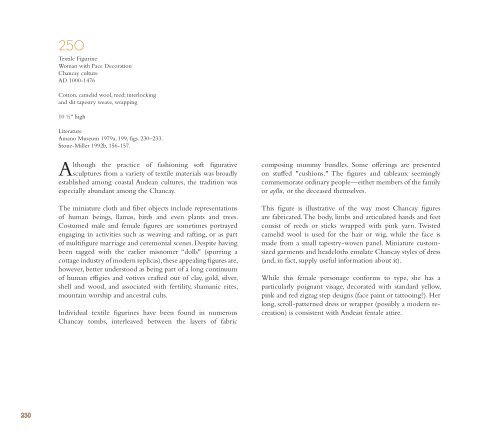You also want an ePaper? Increase the reach of your titles
YUMPU automatically turns print PDFs into web optimized ePapers that Google loves.
250<br />
Textile Figurine<br />
Woman with Face Decoration<br />
Chancay culture<br />
AD 1000-1476<br />
Cotton, camelid wool, reed; interlocking<br />
and slit tapestry weave, wrapping<br />
10 ½" high<br />
Literature<br />
Amano Museum 1979a, 199, figs. 230–233.<br />
Stone-Miller 1992b, 156-157.<br />
Although <strong>the</strong> practice of fashioning soft figurative<br />
sculptures from a variety of textile materials was broadly<br />
established among coastal Andean cultures, <strong>the</strong> tradition was<br />
especially abundant among <strong>the</strong> Chancay.<br />
The miniature cloth and fiber objects include representations<br />
of human beings, llamas, birds and even plants and trees.<br />
Costumed male and female figures are sometimes portrayed<br />
engaging in activities such as weaving and rafting, or as part<br />
of multifigure marriage and ceremonial scenes. Despite having<br />
been tagged with <strong>the</strong> earlier misnomer “dolls" (spurring a<br />
cottage industry of modern replicas), <strong>the</strong>se appealing figures are,<br />
however, better understood as being part of a long continuum<br />
of human effigies and votives crafted out of clay, gold, silver,<br />
shell and wood, and associated with fertility, shamanic rites,<br />
mountain worship and ancestral cults.<br />
Individual textile figurines have been found in numerous<br />
Chancay tombs, interleaved between <strong>the</strong> layers of fabric<br />
composing mummy bundles. Some offerings are presented<br />
on stuffed "cushions." The figures and tableaux seemingly<br />
commemorate ordinary people—ei<strong>the</strong>r members of <strong>the</strong> family<br />
or ayllu, or <strong>the</strong> deceased <strong>the</strong>mselves.<br />
This figure is illustrative of <strong>the</strong> way most Chancay figures<br />
are fabricated. The body, limbs and articulated hands and feet<br />
consist of reeds or sticks wrapped with pink yarn. Twisted<br />
camelid wool is used for <strong>the</strong> hair or wig, while <strong>the</strong> face is<br />
made from a small tapestry-woven panel. Miniature customsized<br />
garments and headcloths emulate Chancay styles of dress<br />
(and, in fact, supply useful information about it).<br />
While this female personage conforms to type, she has a<br />
particularly poignant visage, decorated with standard yellow,<br />
pink and red zigzag step designs (face paint or tattooing?). Her<br />
long, scroll-patterned dress or wrapper (possibly a modern recreation)<br />
is consistent with Andean female attire.<br />
230







